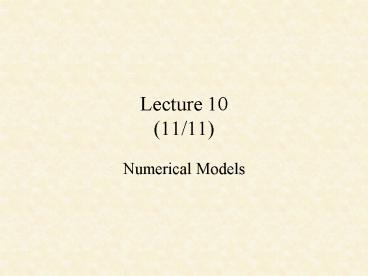Numerical Models - PowerPoint PPT Presentation
Title:
Numerical Models
Description:
Lecture 10 (11/11) Numerical Models Numerical Weather Prediction Numerical Weather Prediction (NWP) uses the power of computers and equations to make forecasts Run on ... – PowerPoint PPT presentation
Number of Views:85
Avg rating:3.0/5.0
Title: Numerical Models
1
Lecture 10 (11/11)
- Numerical Models
2
Numerical Weather Prediction
- Numerical Weather Prediction (NWP) uses the power
of computers and equations to make forecasts - Run on supercomputers
- Provide predictions for many atmospheric
variables like temperature, pressure, wind, and
precipitation
3
More on NWP
- NWP is not perfect
- Bad Data (sensor is messed up)
- Data not representative of surroundings
- Gaps in available data
- Equations in model not perfect
- Some assumptions made
- Chaos theory - small scale stuff can have a
significant effect on weather
4
More problems
- If initial state (called the initialization or
analysis) is not accurate, then computers
prediction of how initial state evolves could be
especially bad - Despite these problems, models are often quite
accurate - Important to know strengths and weaknesses of
models and how they work
5
Good Forecasts
- A good forecast can often be made with a
meteorologist interpreting model data and adding
his/her own expertise - Model or forecaster alone problems
- Model forecaster usually works well
- As research and technology advances, weather
models are updated (several times a year) to try
to make more accurate forecasts
6
Key Things to Remember
- When looking at model data, always
- Look at the date and time - make sure its for
the period you want to look at - Look at the initialization - does it closely
match the current conditions? If not, the
forecasts are probably bad too - Does it make sense? - A blizzard in Norman in
August probably would not happen!
7
The Models
- The major models
- Eta model (ETA)
- Aviation model (AVN)
- Nested Grid Model (NGM)
- Medium Range Forecast Model (MRF)
- Rapid Update Cycle (RUC)
- European Center for Medium Range Weather
Forecasting (ECMWF) - most important
8
ETA model
- Most widely used model in operational meteorology
in U.S. - Better than other models for convective
precipitation (like thunderstorms) - Gives 3 day forecasts
- The 0 12Z cycles run out to 60 hours, the 06
18Z cycles run to 48 hours. - Run twice a day at 0z and 12z with output for
every 12 hours out to 60 hours.
9
Aviation Model
- Covers entire Northern Hemisphere
- Useful for looking upstream and around the world
- Less detailed than ETA over U.S. but also a
pretty good model - Forecasts out to 84 hrs at 6Z 18Z and all the
way out to 126 hours at 0Z 12Z
10
MRF model
- Produces medium range forecasts (like the name
suggests) - Version of AVN that is run out to 14 days
- Dont bet on the 7-14 day forecasts being
accurate - Good for a longer look at weather
11
RUC model
- RUC Rapid Update Cycle
- Run every 3 hours for forecasts out to 12 hours
- Helps for forecasts for the next few hours
- Designed to incorporate the latest weather
parameters every 3 hours (temps, dewpoints,
winds, pressures, etc.)
12
Comparing (ETA vs MRF)
13
Comparing (AVN vs NGM)
14
Model Output Statistics
- Called MOS for short (gotta love acronyms!)
- Found on Rossby using the Weather command
- Presents model forecasts in a text format
- Often can give more background forecast
information
15
MOS (AVN example)
16
Web pages for Model Output
- Remember you can always go to http//weather.ou.ed
u/wx and click on links - Unisys http//weather.unisys.com
- Texas AM (click on model output)
http//www.met.tamu.edu/weather.shtml - NCAR http//www.rap.ucar.edu/weather
17
For Next time
- Read Ch 7 (Snow and Ice) about riveting topics
like Snow and Ice ) - Next homework on web
- For the homework, youll need to read part 1 of
tutorial 20 from the following website
http//www.met.tamu.edu/class/Metr151/151home.html
(see hmwk for more details)































